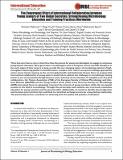Files in this item
The convergent effect of international collaboration between young leaders of two global societies : strengthening microbiology education and training practices worldwide
Item metadata
| dc.contributor.author | Meštrović, Tomislav | |
| dc.contributor.author | Cevik, Muge | |
| dc.contributor.author | Pinto, Tatiana Castro Abreu | |
| dc.contributor.author | Barać, Aleksandra | |
| dc.contributor.author | Servín-Garcidueñas, Luis E | |
| dc.contributor.author | Ong, David S Y | |
| dc.date.accessioned | 2019-06-18T13:30:08Z | |
| dc.date.available | 2019-06-18T13:30:08Z | |
| dc.date.issued | 2019-04 | |
| dc.identifier | 259337291 | |
| dc.identifier | d40d9220-b5f4-4ae6-9c2f-d544c0c58ff8 | |
| dc.identifier | 31160928 | |
| dc.identifier | 85070747426 | |
| dc.identifier.citation | Meštrović , T , Cevik , M , Pinto , T C A , Barać , A , Servín-Garcidueñas , L E & Ong , D S Y 2019 , ' The convergent effect of international collaboration between young leaders of two global societies : strengthening microbiology education and training practices worldwide ' , Journal of Microbiology & Biology Education , vol. 20 , no. 1 . https://doi.org/10.1128/jmbe.v20i1.1669 | en |
| dc.identifier.issn | 1935-7877 | |
| dc.identifier.other | PubMedCentral: PMC6508899 | |
| dc.identifier.other | ORCID: /0000-0003-1133-3874/work/60196680 | |
| dc.identifier.uri | https://hdl.handle.net/10023/17922 | |
| dc.description.abstract | There has never been a more critical time than the present for young microbiologists to engage in continuous postgraduate education. Next-generation microbiologists need to integrate several scientific disciplines in the early stages of their careers to keep up with the ever-changing nature of microbiology (advent of high-throughput sequencing platforms, bioinformatics, complex omic, culture and systems-biology approaches) and to ensure timely response to the current global health and biodiversity threats. Here we propose that international collaboration of young experts would help to address the challenges in microbiology training and serve as a communication bridge between senior and early career scientists. To establish a one-of-a-kind collaboration, the Trainee Association (TAE) of the European Society of Clinical Microbiology and Infectious Diseases (ESCMID) and the Young Leaders Circle (YLC) of the American Society for Microbiology (ASM) have joined forces to adequately represent the interests of young members within the two largest societies in the field of microbiology. Through this partnership, both societies aim to promote continuous education for young scientists and the general public. Additionally, we intend to identify shared objectives and introduce joint activities that could lead to a beneficial exchange process for a long-lasting relationship. This partnership further contributes to advancing both the quality and quantity of education. | |
| dc.format.extent | 6 | |
| dc.format.extent | 308212 | |
| dc.language.iso | eng | |
| dc.relation.ispartof | Journal of Microbiology & Biology Education | en |
| dc.subject | L Education | en |
| dc.subject | QR Microbiology | en |
| dc.subject | T-NDAS | en |
| dc.subject | SDG 3 - Good Health and Well-being | en |
| dc.subject.lcc | L | en |
| dc.subject.lcc | QR | en |
| dc.title | The convergent effect of international collaboration between young leaders of two global societies : strengthening microbiology education and training practices worldwide | en |
| dc.type | Journal article | en |
| dc.contributor.institution | University of St Andrews. School of Medicine | en |
| dc.identifier.doi | https://doi.org/10.1128/jmbe.v20i1.1669 | |
| dc.description.status | Peer reviewed | en |
This item appears in the following Collection(s)
Items in the St Andrews Research Repository are protected by copyright, with all rights reserved, unless otherwise indicated.

